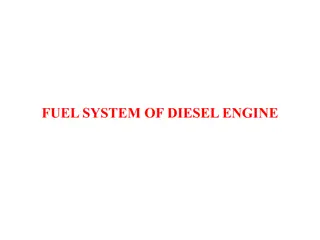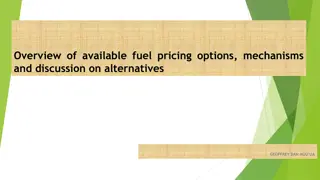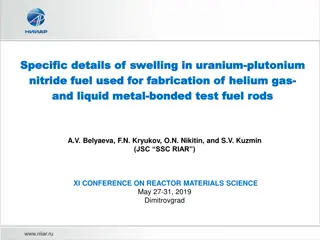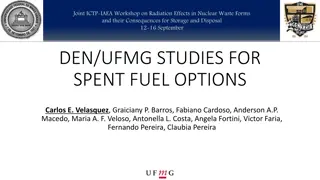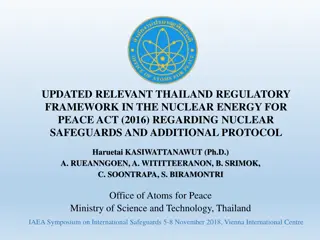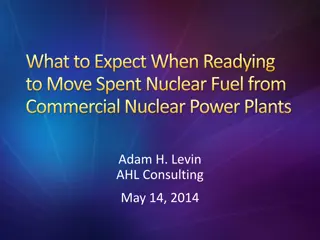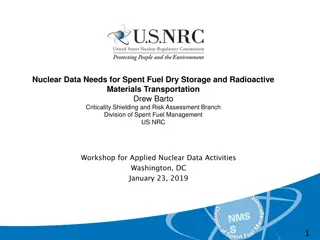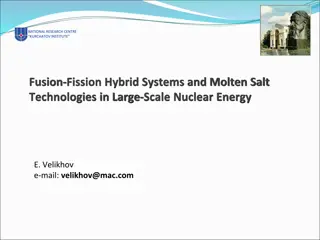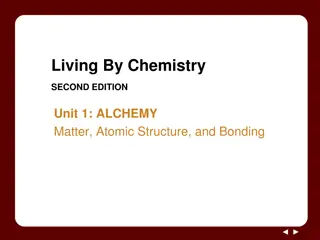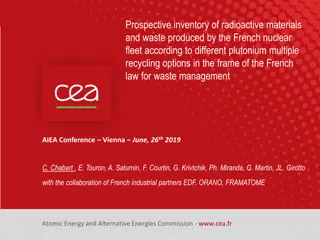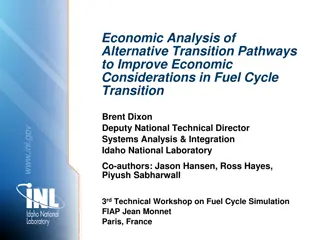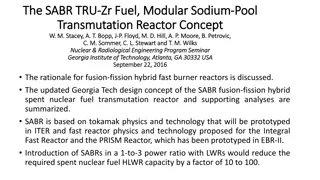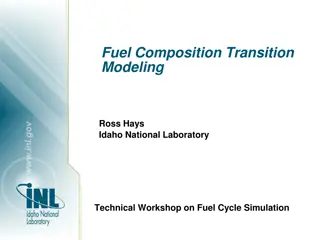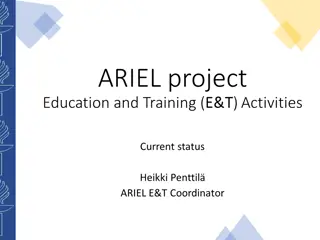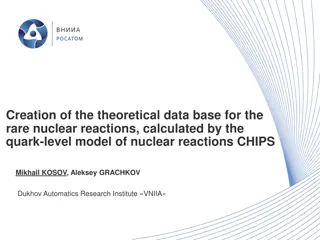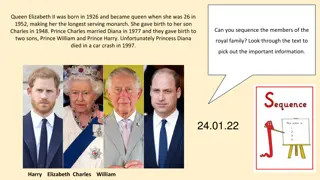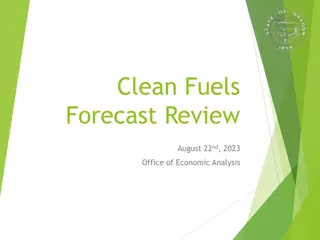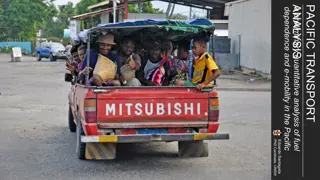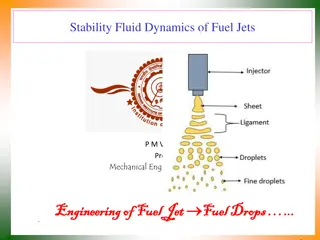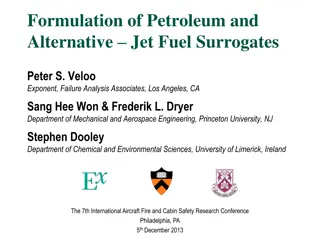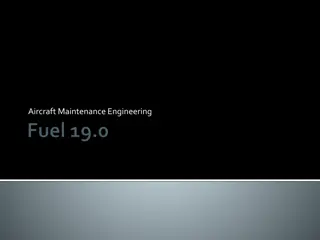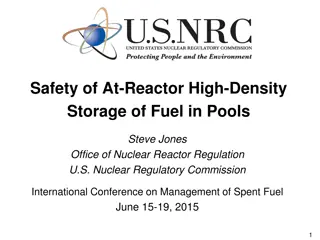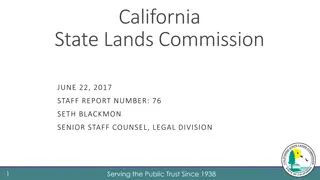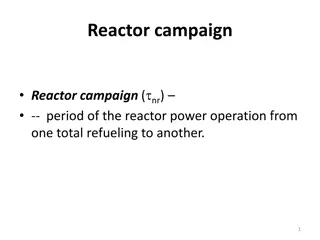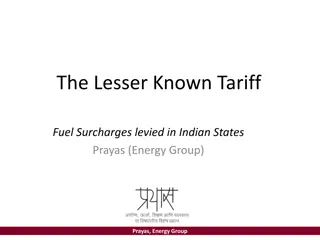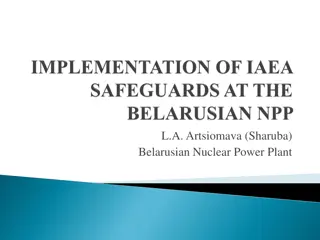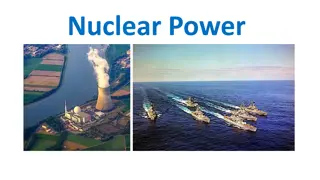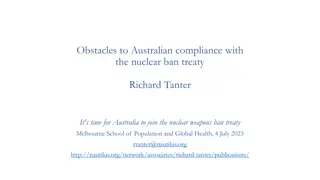Nuclear Fuel Cycle Royal Commission Report 2015-2016 Summary
The Nuclear Fuel Cycle Royal Commission in South Australia from 2015-2016, led by Peter Trebilco, aimed to investigate the feasibility of the nuclear fuel cycle in the state. The Premier highlighted the importance of a mature debate in the community and the potential economic opportunities. The Commission considered risks and opportunities in various stages like Exploration, Extraction, Milling, Processing, Electricity Generation, and Management. The report advocated for simplification of approval processes for radioactive ore mining and securing decommissioning costs upfront.
Download Presentation

Please find below an Image/Link to download the presentation.
The content on the website is provided AS IS for your information and personal use only. It may not be sold, licensed, or shared on other websites without obtaining consent from the author. Download presentation by click this link. If you encounter any issues during the download, it is possible that the publisher has removed the file from their server.
E N D
Presentation Transcript
Nuclear Fuel Cycle Royal Commission, South Australia 2015-2016 REPORT Peter Trebilco Visiting Fellow School of Public Health and Community Medicine School of Public Health and Community Medicine School of Public Health and Community Medicine UNSW Australia
In March 2015, the Premier of South Australia said The process has been informed by a mostly mature debate within the community The terms of for the commission were shaped by extensive consultation thorough a four-week period, with more than 1,000 submissions received from the community. Today is a significant moment in our state s history.
He continued= The royal commission will provide a thorough investigation of the nuclear fuel cycle and its feasibility in South Australia. This is an opportunity for our state to maturely and rationally consider economic opportunities that have the power to shape our future. (Hansard 15 March 2015, 14.05)
Terms of Reference In inquiring into the risks and opportunities associated with Exploration, Extraction and Milling, Further Processing and Manufacture, Electricity Generation, Management, Storage and Disposal,
consideration should be given, as appropriate, to the future impact on the South Australian a. economy (including the potential for the development of related sections and adverse impact on other sections); b. environment (including considering lessons learned from past South Australian extractions, milling and processing practices); and c. community (incorporating regional, remote and Aboriginal communities) including potential impacts on health and safety .
Chapter 2 of the Report deals with the exploration and mining of radioactive waste: the South Australian Government pursue the simplification of state and federal mining approval requirements for radioactive ores, to deliver a single assessment and approval process. to ensure the full costs of decommissioning and remediation with respect to radioactive ore mining projects are secured in advance from miners through associated guarantees. (p. xiv).
As of 2013, the ageing Ranger mine and has incurred financial losses in recent years, as a result of the continuing market slump which has followed the 2011 Fukushima nuclear disaster. Water management and waste management continue to be controversial issues. (Wikipedia accessed 21/08/16)
Mining and mining activities for all minerals pose risks to human health and the environment, which need to be managed. If expanded, uranium mining and milling activities in South Australia would create similar risks to those arising from current uranium mining activities. (p. 9)
In 2014, the OECD Nuclear Energy Agency published a 140 page report, Managing Environmental and Health Impacts of Uranium Mining. Uranium mining and milling has evolved significantly over the years. By comparing currently leading approaches with outdated practices, this report demonstrates how uranium mining can be conducted in a way that protects workers, the public and the environment.
Innovative, modern mining practices combined with strictly-enforced regulatory standards are geared towards avoiding past mistakes committed primarily during the early history of the industry when maximising uranium production was the principal operating consideration.
Michael Schulter, founder of Britains Relationship Foundation has suggested 10 rules for a relationship business charter . Rule 1: To become a profitable and sustainable business for the benefit of ALL its stake holders- owners, directors, managers, employees, suppliers, customers and the wider society.
Englands Office of Nuclear Regulation publishes Safety Assessments Principles for Nuclear Facilities (first published in 1979 and its current edition 2014) has to regulate the safety standards of 37 nuclear sites in England; Scotland regulatory authority is independent, and Wales is in communication.
Safety Assessment Principal (SAP) 50 Protection must be optimised to provide the highest level of safety that is reasonably practicable and Dutyholders must demonstrate effective understanding and control of the hazards posed by a site or facility through a comprehensive and systematic process of safety assessment.
Uranium tailings contain over a dozen radioactive nuclides, which are the primary hazard posed by the tailings. The most important of these are thorium-230, radium-226, radon - 222 (radon gas) and the daughter isotopes of radon decay, including polonium-210. An EPA estimate of risk based on uranium tailings deposits existing in the United States in 1983 gave the figure of 500 lung cancer deaths per century if no countermeasures are taken. (Wikipedia accessed 21/08/16)
The Australian Department of Industry, Innovation and Science commissioned a report from its Independent Advisory Panel (IAP) to advise on the selection of a National Radioactive Waste Management Facility in Australia. I
n its Summary Report, the IAP wrote: In responding to these concerns ( many of those opposed) ..were entrenched in their views of not moving forward . It was also evident that from the consultations that there were a range of common concerns across all communities. These concerns include the fear that a proposed facility (there were 6 sites nominated) impact tourism, agricultural reputations and property values.
Chapter 3 of the Report is Further processing and manufacturing (from Radioactive Ores) : many of these materials are already used and safely managed in Australia. Some risks would require new regulatory frameworks. (p. xiv). Recommendation 25. There is no technical impediment to providing conversion, enrichment to fuel fabrication services in Australia: (p 31)
Professor Mark Diesendorf, Interdisciplinary Environment Studies, UNSW, in Energy Research and Social Sciences, July 2016, writes: In its Final Report, issued 6 May 2016, it acknowledges that nuclear power would not be commercially viable in South Australia in the foreseeable future.
He continues- However, it recommends that the South Australian Government establish used nuclear fuel and intermediate level waste storage disposal facilities in South Australia. This is a business proposition to store a large fraction of global nuclear wastes, providing interim above-ground storage followed by permanent underground storage in South Australia.
And further: The present critical evaluation of the scheme finds that the Royal Commission's economic analysis is based on many unsubstantial assumptions. Furthermore, the scheme is financially risky for both the taxpayers and the customers and has a questionable (environmental) ethical basis.
Chapter 10: Recommendations and Next Steps contains the major ethical environmental health threat: The expansion of uranium mining in South Australia will provide additional benefits to the state. Simplifying the existing regulatory approvals process, and enhancing the further integration and public availability of geophysical data, would help to realise these benefits. (p 170).
Weasel words are sometimes a form of argument from authority or argument from popular opinion, which many people believe are logical fallacies. Weasel words are widely considered to be a sign of intellectual laziness. Most people use weasel words a lot without realizing it, even when they are writing an article on weasel words. This problem is believed by many to be widespread.
Examples from the radioactive and hazardous wastes producing industries: Relatively Reasonable Tolerable Strongly regulated Safely managed
A wondrous example: In contrast to radioactive waste, deep geological disposal for some especially hazardous long lived wastes has already been successfully achieved in some countries. (Radioactive Waste in Perspective, Nuclear Energy Agency, OECD)
If I have offended, pray pardon; I did but speak openly. Thank you Questions?


